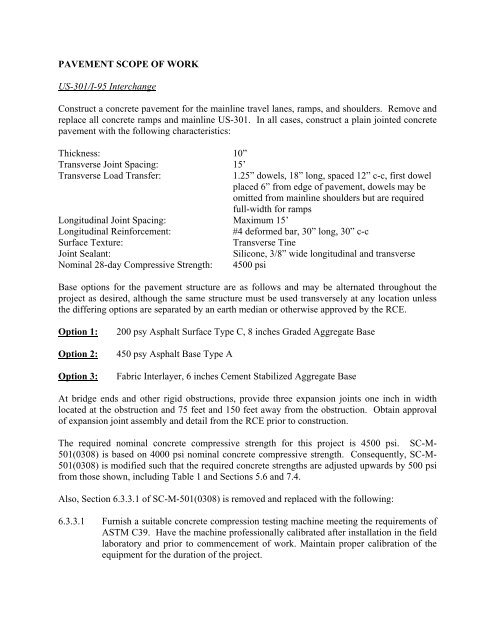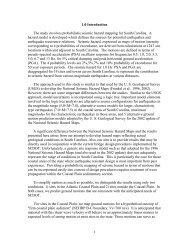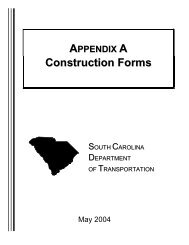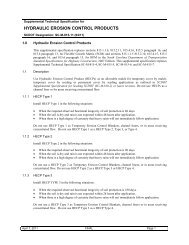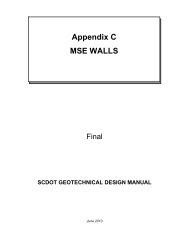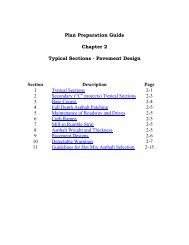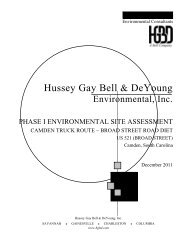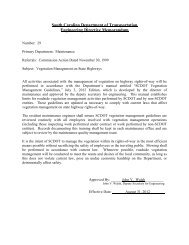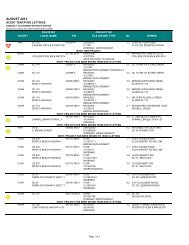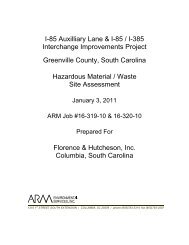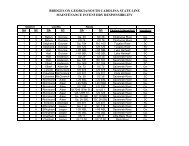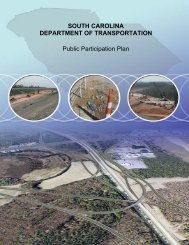PAVEMENT SCOPE OF WORK US-301/I-95 Interchange ... - SCDOT
PAVEMENT SCOPE OF WORK US-301/I-95 Interchange ... - SCDOT
PAVEMENT SCOPE OF WORK US-301/I-95 Interchange ... - SCDOT
You also want an ePaper? Increase the reach of your titles
YUMPU automatically turns print PDFs into web optimized ePapers that Google loves.
<strong>PAVEMENT</strong> <strong>SCOPE</strong> <strong>OF</strong> <strong>WORK</strong><br />
<strong>US</strong>-<strong>301</strong>/I-<strong>95</strong> <strong>Interchange</strong><br />
Construct a concrete pavement for the mainline travel lanes, ramps, and shoulders. Remove and<br />
replace all concrete ramps and mainline <strong>US</strong>-<strong>301</strong>. In all cases, construct a plain jointed concrete<br />
pavement with the following characteristics:<br />
Thickness: 10”<br />
Transverse Joint Spacing: 15’<br />
Transverse Load Transfer: 1.25” dowels, 18” long, spaced 12” c-c, first dowel<br />
placed 6” from edge of pavement, dowels may be<br />
omitted from mainline shoulders but are required<br />
full-width for ramps<br />
Longitudinal Joint Spacing: Maximum 15’<br />
Longitudinal Reinforcement: #4 deformed bar, 30” long, 30” c-c<br />
Surface Texture: Transverse Tine<br />
Joint Sealant: Silicone, 3/8” wide longitudinal and transverse<br />
Nominal 28-day Compressive Strength: 4500 psi<br />
Base options for the pavement structure are as follows and may be alternated throughout the<br />
project as desired, although the same structure must be used transversely at any location unless<br />
the differing options are separated by an earth median or otherwise approved by the RCE.<br />
Option 1: 200 psy Asphalt Surface Type C, 8 inches Graded Aggregate Base<br />
Option 2: 450 psy Asphalt Base Type A<br />
Option 3: Fabric Interlayer, 6 inches Cement Stabilized Aggregate Base<br />
At bridge ends and other rigid obstructions, provide three expansion joints one inch in width<br />
located at the obstruction and 75 feet and 150 feet away from the obstruction. Obtain approval<br />
of expansion joint assembly and detail from the RCE prior to construction.<br />
The required nominal concrete compressive strength for this project is 4500 psi. SC-M-<br />
501(0308) is based on 4000 psi nominal concrete compressive strength. Consequently, SC-M-<br />
501(0308) is modified such that the required concrete strengths are adjusted upwards by 500 psi<br />
from those shown, including Table 1 and Sections 5.6 and 7.4.<br />
Also, Section 6.3.3.1 of SC-M-501(0308) is removed and replaced with the following:<br />
6.3.3.1 Furnish a suitable concrete compression testing machine meeting the requirements of<br />
ASTM C39. Have the machine professionally calibrated after installation in the field<br />
laboratory and prior to commencement of work. Maintain proper calibration of the<br />
equipment for the duration of the project.
To provide continuity when tying onto existing I-<strong>95</strong> pavement, perform the following steps in<br />
whatever order is necessary to stage the construction safely and efficiently:<br />
Minimally micromill 3 inches from the existing mainline to remove the Open Graded<br />
Friction Course (OGFC) (approximately 1 inch thick) and the top lift of Asphalt Surface<br />
(approximately 2 inches thick). This should leave approximately 2 inches of Asphalt<br />
Surface and variable amounts of asphalt leveling over the original I-<strong>95</strong> concrete<br />
pavement.<br />
Construct new concrete pavement structure for the tie-ins to the elevation of the original<br />
I-<strong>95</strong> concrete pavement. It is not necessary to tie the new concrete to the existing or<br />
place expansion material between the old and new pavements. However, include a<br />
coating of curing compound on the side of the existing pavement at twice the required<br />
rate for new concrete to inhibit bonding prior to paving.<br />
Overlay the concrete in the transition with 200 psy Asphalt Surface Type B to the<br />
elevation of the mainline after micromilling.<br />
Overlay the I-<strong>95</strong> mainline and transitions with 200 psy Asphalt Surface Type A and 110<br />
psy OGFC.<br />
Carry the ramp asphalt to beyond the gore areas, then provide a neat transverse transition<br />
to the concrete surface. Construct two variable thickness transition slabs to provide a<br />
“step” into which the asphalt may be terminated. The first transition would terminate the<br />
Asphalt Surface Type B and the second transition would terminate the Asphalt Surface<br />
Type A and the OGFC.<br />
Concrete surfaces that will be overlaid with asphalt as part of this work may be left roughly<br />
textured to provide a better bond with the asphalt.<br />
To tie into existing <strong>US</strong>-<strong>301</strong>, construct the initial slab at the asphalt/concrete joint at variable<br />
thickness ranging from 15 inches at the free end to 10 inches at the first contraction joint. Mill<br />
the existing asphalt 2” and replace the milled material with 200 psy Asphalt Surface Type A.<br />
Ltd Road/Kenlake Court Access Road<br />
Construct either a concrete or asphalt pavement. For the concrete pavement alternative,<br />
construct a plain jointed concrete section with the following characteristics:<br />
Thickness: 6”<br />
Transverse Joint Spacing: 12’<br />
Transverse Load Transfer: None<br />
Longitudinal Joint Spacing: 15’ maximum<br />
Longitudinal Reinforcement: #4 deformed bar, 30” long, 30” c-c<br />
Surface Texture: Transverse Tine<br />
Joint Sealant: None. Single cut width longitudinal and transverse<br />
Nominal 28-day Compressive Strength: 4000 psi
Construct concrete pavement directly on subgrade. The longitudinal reinforcement may be<br />
eliminated if the transverse joint spacing is reduced to 6 feet and an additional longitudinal joint<br />
is added in the center of each lane between the wheel paths.<br />
For the asphalt pavement alternative, construct the following:<br />
150 psy Asphalt Surface Type C<br />
200 psy Asphalt Intermediate Type B<br />
8 inches Graded Aggregate Base<br />
450 psy Asphalt Base Type B or 6 inches Cement Stabilized Aggregate Base may be used in lieu<br />
of the 8 inches Graded Aggregate Base.<br />
SC-6<br />
For widening of SC-6, overlay the existing pavement with at least 200 psy Asphalt Surface Type<br />
B. Construct widening and turn lanes on SC-6 with the following structure:<br />
200 psy Asphalt Surface Type B<br />
200 psy Asphalt Intermediate Type B<br />
850 psy Asphalt Base Type A<br />
8 inches of Cement Stabilized Aggregate Base may be used in lieu of the 850 psy Asphalt Base<br />
Type A. Additionally, 300 psy Asphalt Base Type A and 10 inches Graded Aggregate Base or<br />
400 psy Asphalt Base Type A and 8 inches Graded Aggregate Base may also be used in lieu of<br />
the 850 psy Asphalt Base Type A.


